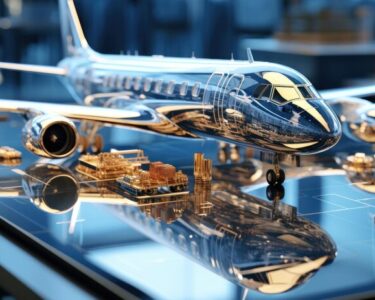The aviation industry constantly evolves, driven by technological advancements and the relentless pursuit of safety, efficiency, and performance.
At the heart of this evolution is the integration and standardization of avionics systems, which play a crucial role in modern aircraft operations. One of the pivotal standards contributing to this progress is ARINC 759.
ARINC 759, developed by Aeronautical Radio, Inc. (ARINC), is a set of specifications aimed at standardizing the integration and communication of avionics systems within aircraft.
Its significance lies not only in its technical specifications but also in its ability to foster innovation and interoperability across different avionics systems and platforms.
As the aviation industry looks toward the future, ARINC 759 is poised to play an instrumental role in shaping the next generation of aircraft technology.
This article delves into how ARINC 759 is influencing the design, performance, and safety of future aircraft, ensuring they are more advanced, reliable, and capable of meeting the growing demands of the industry.
Integration of ARINC 759 in Future Avionics Systems
The integration of ARINC 759 into future avionics systems promises to revolutionize the way aircraft components communicate and work together, leading to enhanced efficiency, reliability, and safety.
As aviation technology progresses, the need for seamless interoperability between various avionics systems becomes increasingly critical.
ARINC 759 addresses this need by providing a standardized framework that facilitates improved integration and data exchange.
Enhanced Interoperability and Integration
One of the primary benefits of ARINC 759 is its ability to enhance interoperability between different avionics systems. By adhering to a common set of specifications, avionics manufacturers can ensure their systems are compatible with other components, regardless of the manufacturer.
This standardization simplifies the integration process, reducing the time and cost associated with developing and certifying new aircraft systems.
For instance, in the context of navigation and communication systems, ARINC 759 ensures that data from GPS, inertial navigation systems, and other sensors can be seamlessly integrated and shared.
This interoperability enables more accurate and reliable navigation, which is crucial for both commercial and military aviation.
Improved Communication and Data Exchange
ARINC 759 also enhances the communication and data exchange capabilities of avionics systems. By standardizing the protocols and data formats used for communication, ARINC 759 ensures that information is transmitted efficiently and accurately between different systems.
This is particularly important for the integration of advanced avionics technologies, such as fly-by-wire systems, which rely on precise and timely data exchange to function correctly.
In future aircraft, the integration of ARINC 759 will support more sophisticated data fusion techniques, where information from multiple sensors and systems is combined to provide a comprehensive situational awareness picture.
This capability is essential for advanced flight management systems, which need to process vast amounts of data in real time to optimize flight paths, reduce fuel consumption, and enhance safety.
Case Studies of Successful Integration in Recent Aircraft Models
Several recent aircraft models have successfully integrated ARINC 759, demonstrating its practical benefits and potential for future applications.
For example, the latest commercial airliners from major manufacturers such as Boeing and Airbus incorporate ARINC 759 standards in their avionics suites.
This integration has resulted in improved system performance, greater reliability, and enhanced operational capabilities.
One notable example is the Boeing 787 Dreamliner, which utilizes ARINC 759-compliant systems to achieve unprecedented levels of efficiency and connectivity.
The integration of ARINC 759 has enabled the 787 to benefit from advanced flight management and navigation systems, contributing to its reputation as one of the most technologically advanced commercial aircraft in service today.
Similarly, military aircraft such as the F-35 Lightning II have adopted ARINC 759 standards to enhance their avionics systems. The F-35’s advanced sensor fusion capabilities, which combine data from radar, infrared, and other sensors, rely on the standardized communication protocols provided by ARINC 759.
This integration ensures that pilots have access to comprehensive and accurate situational awareness, which is critical for mission success and safety.

Impact on Aircraft Performance and Safety
The adoption of ARINC 759 in avionics systems significantly impacts both aircraft performance and safety, addressing some of the most critical aspects of modern aviation. By standardizing the integration and communication protocols of avionics components, ARINC 759 enhances the efficiency, reliability, and safety of aircraft operations.
Contributions to Overall Aircraft Performance
ARINC 759 contributes to improved aircraft performance through several mechanisms:
- Optimized Data Management:
- By ensuring that avionics systems can seamlessly communicate and share data, ARINC 759 facilitates more efficient data management. This optimized data flow allows for better decision-making and real-time adjustments, enhancing overall aircraft performance.
- Enhanced System Integration:
- The standardization provided by ARINC 759 allows for easier integration of advanced avionics systems, such as next-generation flight management systems and autopilot functions. These systems can operate more effectively when they can communicate smoothly, leading to improved flight efficiency and reduced pilot workload.
- Improved Navigation and Flight Efficiency:
- With ARINC 759, navigation systems can more accurately process and integrate data from multiple sources, such as GPS, inertial measurement units (IMUs), and ground-based navigation aids. This integration leads to more precise flight paths, optimal route planning, and reduced fuel consumption, contributing to both economic and environmental benefits.
Enhancements in Safety Measures and Reliability
Safety is paramount in aviation, and ARINC 759 plays a crucial role in enhancing aircraft safety and reliability:
- Redundancy and Fault Tolerance:
- ARINC 759 supports the implementation of redundant systems and fault-tolerant architectures. By ensuring that critical avionics systems can operate independently yet cohesively, ARINC 759 helps prevent single points of failure and enhances the overall resilience of the aircraft.
- Real-Time Monitoring and Diagnostics:
- The standardized communication protocols of ARINC 759 enable more effective real-time monitoring and diagnostics of avionics systems. Maintenance teams can quickly identify and address issues before they escalate, reducing the likelihood of in-flight malfunctions and improving overall aircraft reliability.
- Enhanced Situational Awareness:
- The ability to integrate and display data from multiple sensors and systems provides pilots with a comprehensive situational awareness picture. ARINC 759 facilitates the fusion of data from radar, weather systems, traffic collision avoidance systems (TCAS), and other sensors, allowing pilots to make informed decisions swiftly and accurately.
- Advanced Safety Features:
- ARINC 759 supports the integration of advanced safety features such as automated emergency response systems and enhanced ground proximity warning systems (EGPWS). These systems rely on accurate and timely data exchange to function effectively, helping to prevent accidents and incidents.
Examples of Safety Features Enabled by ARINC 759
- Terrain Awareness and Warning Systems (TAWS):
- ARINC 759 enables the integration of TAWS, which alerts pilots to potential terrain collisions. By processing data from various sensors and navigation systems, TAWS provide real-time alerts, giving pilots ample time to take corrective action.
- Traffic Collision Avoidance System (TCAS):
- TCAS relies on ARINC 759 standards to communicate with other aircraft and ground systems. By ensuring reliable data exchange, TCAS can accurately detect and resolve potential mid-air collisions, enhancing flight safety.
- Automatic Dependent Surveillance-Broadcast (ADS-B):
- ADS-B systems, which provide real-time position information to air traffic control and other aircraft, benefit from the standardized communication protocols of ARINC 759. This integration improves situational awareness and reduces the risk of collisions.
Supporting Innovations in Aircraft Design
ARINC 759 plays a pivotal role in supporting innovations in aircraft design, enabling the development of more efficient, sustainable, and advanced aviation technologies. By providing a standardized framework for integrating avionics systems, ARINC 759 facilitates the adoption of new technologies and design approaches that push the boundaries of what is possible in aviation.
Role in the Development of More Efficient and Sustainable Aircraft
- Lightweight and Modular Avionics Systems:
- ARINC 759 supports the design of lightweight and modular avionics systems that can be easily upgraded or replaced. This modularity allows for more flexible aircraft designs, reducing weight and improving fuel efficiency. Additionally, it simplifies maintenance and reduces downtime, contributing to overall operational efficiency.
- Advanced Aerodynamics and Materials:
- The integration capabilities of ARINC 759 enable the use of advanced aerodynamics and innovative materials. By ensuring that avionics systems can effectively communicate and function with cutting-edge design elements, ARINC 759 supports the development of aircraft with improved aerodynamic performance and fuel efficiency.
- Green Aviation Technologies:
- ARINC 759 facilitates the incorporation of green aviation technologies, such as electric and hybrid propulsion systems. By standardizing the integration of these technologies with traditional avionics systems, ARINC 759 helps create more environmentally friendly aircraft that reduce carbon emissions and reliance on fossil fuels.
Support for Next-Generation Navigation and Control Systems
- Enhanced Flight Management Systems (FMS):
- ARINC 759 enables the integration of next-generation flight management systems that offer more precise navigation and route optimization. These advanced FMS can leverage real-time data from various sensors and systems to calculate the most efficient flight paths, reducing fuel consumption and flight times.
- Autonomous and Semi-Autonomous Flight Technologies:
- The standardized communication protocols of ARINC 759 are crucial for the development of autonomous and semi-autonomous flight technologies. By ensuring reliable data exchange between avionics systems, ARINC 759 supports the implementation of advanced autopilot functions and automated flight control systems, paving the way for future autonomous aircraft.
- Improved Human-Machine Interfaces (HMI):
- ARINC 759 facilitates the development of improved human-machine interfaces, such as touchscreens and voice-activated controls. These advanced interfaces enhance pilot situational awareness and reduce workload, contributing to safer and more efficient flight operations.
Potential for Facilitating Autonomous and Semi-Autonomous Flight Technologies
- Sensor Integration and Data Fusion:
- Autonomous and semi-autonomous flight systems rely on the integration of multiple sensors, including radar, lidar, cameras, and GPS. ARINC 759 provides a framework for integrating these sensors and fusing their data, enabling more accurate and reliable autonomous flight operations.
- Real-Time Decision-Making and Control:
- ARINC 759 supports real-time decision-making and control systems essential for autonomous flight. By standardizing communication protocols, ARINC 759 ensures that critical data is transmitted and processed without delays, allowing autonomous systems to make timely and accurate decisions.
- Redundancy and Fail-Safe Mechanisms:
- The implementation of redundancy and fail-safe mechanisms is vital for the safety of autonomous and semi-autonomous aircraft. ARINC 759’s standardization ensures that these mechanisms can be effectively integrated and managed, enhancing the overall reliability and safety of autonomous flight operations.
Conclusion
ARINC 759 stands as a vital enabler of progress in the aviation industry, playing a critical role in the development and integration of advanced avionics systems.
Its standardized framework ensures enhanced interoperability, efficient data exchange, and robust safety mechanisms, all of which contribute significantly to the performance and reliability of modern aircraft.
By facilitating the seamless integration of diverse avionics components, ARINC 759 not only improves current aircraft performance and safety but also paves the way for future innovations.
From optimizing flight management systems and supporting green aviation technologies to enabling autonomous and semi-autonomous flight, ARINC 759 is at the forefront of technological advancements in aviation.
As the industry continues to push the boundaries of what is possible, ARINC 759 will remain indispensable in fostering innovation and maintaining high standards of safety and efficiency.
Its impact on aircraft design, performance, and safety underscores the importance of continued investment in and adherence to standardized avionics protocols.
In an era where technological advancements are rapidly transforming aviation, ARINC 759 ensures that the industry can meet the growing demands for more efficient, sustainable, and advanced aircraft.
In conclusion, ARINC 759 is not just a technical standard but a cornerstone of modern and future aircraft technology. Its role in supporting the evolution of aviation systems highlights its enduring value and the necessity for ongoing innovation and standardization in the ever-evolving world of aviation.






